There’s not better way to start off the summer than with some classic games. This month’s Roundtable features a couple of titles that are controversial, to say the least. Love ’em or hate ’em, they’re definitely worth talking about.
Super Hydlide By Ken Horowitz
This is a game that gets no love. People hate the miniscule graphics, the weight system, and the cryptic level design. Undoubtedly, these are all legitimate concerns (though the weight problem no longer becomes an issue further into the game), but they hardly break what is otherwise a great little RPG. The thing I like best about Super Hydlide is that it’s a title that literally sends a player out alone into the wilderness to save the world in a way no other game at the time did.
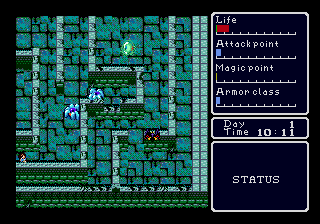 Aside from the usual “here’s 10 gold and a wooden stick. Go forth and conquer!” beginnings most games in the genre have, T&E Soft’s adventure added a bunch of real world issues that the hero had to deal with. At the time, few other console RPGs that I can recall made players consider the actual weight of the items they carried, forced characters to eat and sleep in order to maintain strength, or had an alignment system that punished or rewarded players based on their actions. Having to consider all these factors was almost overwhelming at first, and there was a tremendous sense of anxiety about heading off into dungeons, but eventually it became second nature. Soon, the game’s qualities started to shine, such as the incredible soundtrack (somewhere, there has to be an arranged version!) that still rings in my head regularly, even after 20 years. It made the prospect of tackling those dungeons a bit easier, and I was ecstatic when I found the hidden sound test.
Aside from the usual “here’s 10 gold and a wooden stick. Go forth and conquer!” beginnings most games in the genre have, T&E Soft’s adventure added a bunch of real world issues that the hero had to deal with. At the time, few other console RPGs that I can recall made players consider the actual weight of the items they carried, forced characters to eat and sleep in order to maintain strength, or had an alignment system that punished or rewarded players based on their actions. Having to consider all these factors was almost overwhelming at first, and there was a tremendous sense of anxiety about heading off into dungeons, but eventually it became second nature. Soon, the game’s qualities started to shine, such as the incredible soundtrack (somewhere, there has to be an arranged version!) that still rings in my head regularly, even after 20 years. It made the prospect of tackling those dungeons a bit easier, and I was ecstatic when I found the hidden sound test.
Super Hydlide has a wonderful mix of solid, forward-thinking gameplay and excellent exploration and adventure. It also boasts perhaps the oddest final boss battle in history, and I urge those who show it disdain or have ignored it completely to give it a second look.
Gunstar Heroes By Sebastian Sponsel
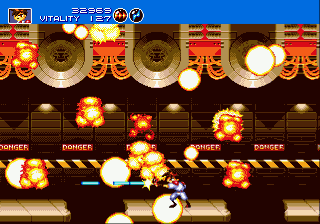 I’ve said it before, but one of my favorite ways to unwind is blowing shit up: Popping in a fast and furious run-‘n-gun and blasting anything that moves away while explosions shatter the screen really helps me relax after a really stressful day and gives me a valve to vent my frustrations and anger of the day. Normally, my go-to game for this is Contra: Hard Corps, but years upon years of repeated playthroughs made me so proficient in the game that it hardly proves a challenge anymore. I’ve heard so many people praise Gunstar Hero as being a great, if not the greatest, run-‘n-gun on the system, so I decided to give it one more try. I played it when it was released, but I hadn’t really touched the game since then.
I’ve said it before, but one of my favorite ways to unwind is blowing shit up: Popping in a fast and furious run-‘n-gun and blasting anything that moves away while explosions shatter the screen really helps me relax after a really stressful day and gives me a valve to vent my frustrations and anger of the day. Normally, my go-to game for this is Contra: Hard Corps, but years upon years of repeated playthroughs made me so proficient in the game that it hardly proves a challenge anymore. I’ve heard so many people praise Gunstar Hero as being a great, if not the greatest, run-‘n-gun on the system, so I decided to give it one more try. I played it when it was released, but I hadn’t really touched the game since then.
And I admit, after starting the game and playing it for a while I started to wonder why I had shunned the game for so many years. Yeah, I prefer the grim and gritty atmosphere of Contra over the comically colorful design of GH. But the gameplay felt solid, the bosses versatile, and it gave me that fast and explosive rush I love from these kind of games. I blasted through the first three levels in no time and began to wonder why I hadn’t given the game another chance for so long.
It was when I reached the fourth stage when I suddenly fired my controller into the corner and exasperatedly yelled “I REMEMBER NOW!” I had reached that stupid board game section!” Who in his right mind has ever believed that throwing in a section completely reliant on chance would improve an otherwise skill-based video game? It wasn’t just that most of the time I only rolled a one or a two, forcing me to inch my way across the “board” and taking on every single enemy encounter there (including that stupid “no guns” fight!). No, of course I had to land on the last field before reaching the boss as well: The one that forces me start the entire board game section all over again. That was the final straw! I shut the game of and banished it once more into the back section of my Mega Drive collection.
Next time I need to unwind, I’ll choose Contra again. Maybe then I’ll manage that single-life run using Fang next time around…
Road Avenger By Christian Matozzo
So this past Christmas here at Sega-16 we organized a little online Secret Santa where we exchanged some video game-related gifts from each others want lists. One of the games I received was Road Avenger for the Sega CD. Now I’m not really well-versed in the FMV genre of games, I’ve actually played very little overall, just some Mad Dog McCree and Dragon’s Lair in arcades. But I had heard that Road Avenger for the Sega CD was really good from the forums and articles here on Sega-16, so I figured I’d write it down on my want list. Well thanks to my Secret Santa, I got a copy! And I just recently got around to playing it because I just got another Sega CD, and without a doubt it has become one of my favorite Sega CD titles.
 Road Avenger is an FMV game for the Sega CD that’s totally hand-drawn in an anime-style (Think Sonic CD). You play as the Road Avenger who’s wife was killed by a bunch of gang members, so you hit the streets and chase down the punks who killed the love of your life. Hit the streets and watch as you, the Road Avenger do amazing car stunts that are so over-the-top I’m not going to even go into detail here. You drive through tons of busy city areas and with each level the game gets more and more over-the-top with the stunts, its really one of the more interesting things I’ve seen in a video game.
Road Avenger is an FMV game for the Sega CD that’s totally hand-drawn in an anime-style (Think Sonic CD). You play as the Road Avenger who’s wife was killed by a bunch of gang members, so you hit the streets and chase down the punks who killed the love of your life. Hit the streets and watch as you, the Road Avenger do amazing car stunts that are so over-the-top I’m not going to even go into detail here. You drive through tons of busy city areas and with each level the game gets more and more over-the-top with the stunts, its really one of the more interesting things I’ve seen in a video game.
As for the gameplay, it’s pretty much trigger-reaction as you follow the on-screen queues as to what button to press. Basically it’s just Left, Right, A for Gas, and B for Break. Nothing complex, but the game is made in such a way that it feels like you’re actually controlling the car and the action all the way. One wrong move though or delayed reaction and your car will crash and you’ll lose a life! Lose them all and it’s game over for the Road Avenger. The game isn’t overly difficult though, but if you find yourself wanting more of a challenge, you can always turn on Hard Mode which turns off the visual cues and makes the game more of a trial-and-error game a la Dragon’s Lair.
Overall, Road Avenger is a must-own for any Sega CD lover. It’s inexpensive online, and really fun. Even if you aren’t an FMV fan you’ll enjoy this game.
X-Men By Greg Jurkiewicz
The X-Men have always been my favourite superhero franchise. I’ve been reading the comics, watching the cartoons and playing the games for as long as I can remember. So naturally the two Genesis games are something that I fall back to whenever I have some time to kill and just feel like beating a game that I know I’m damn good at and can just pick up and beat with a casual effort. The second game gets a lot more praise than the first X title, however both have a very different feel to them, and the first game isn’t without it’s charms.
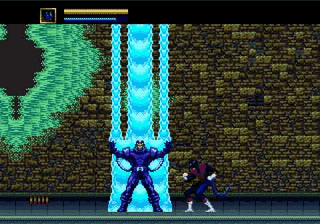 I remember very clearly the day I bought that game. I was 10, and I’d been saving my allowance money for months so that I could finally purchase a new game for my Genesis so that I could have a whopping three games! (Remember, games were expensive back then). So, one afternoon my brother and I went to the Consumers Distributing and I was psyched to not only find an X-Men game, but also to find that it was on sale! $49.99 is what the sign on the shelf said. I could buy that game and still have cash left over for comics after. I was through the roof. I took the game and ran to the cash with it, the cashier scanned and it, and nonchalantly said “that’ll be $80” (and change). My mouth dropped. I told her the shelf said it was $49.99, there was no way that tax on this thing could be over $30. She scanned it again, and that was the price… She said that someone must have mislabeled the game and that it was a new release and definitely not on sale. My brother and I raised such a stink about it that eventually the manager had to come out and talk to us. Luckily, though the guy wasn’t above admitting that one of the staff screwed up when putting up the sale signs and he sold us the game for $49.99. That day was a victory.
I remember very clearly the day I bought that game. I was 10, and I’d been saving my allowance money for months so that I could finally purchase a new game for my Genesis so that I could have a whopping three games! (Remember, games were expensive back then). So, one afternoon my brother and I went to the Consumers Distributing and I was psyched to not only find an X-Men game, but also to find that it was on sale! $49.99 is what the sign on the shelf said. I could buy that game and still have cash left over for comics after. I was through the roof. I took the game and ran to the cash with it, the cashier scanned and it, and nonchalantly said “that’ll be $80” (and change). My mouth dropped. I told her the shelf said it was $49.99, there was no way that tax on this thing could be over $30. She scanned it again, and that was the price… She said that someone must have mislabeled the game and that it was a new release and definitely not on sale. My brother and I raised such a stink about it that eventually the manager had to come out and talk to us. Luckily, though the guy wasn’t above admitting that one of the staff screwed up when putting up the sale signs and he sold us the game for $49.99. That day was a victory.
The victory of beating that game however didn’t come until about two years later when I finally finished the damn thing. It took me about a year and half of playing to finally reach Magneto, and another few moths before I figured out how to beat the bastard. Man, did it ever feel good to beat him though. That triumph was glorious. All the challenges that this game posed made the experience unnaturally satisfying, and even though it may not be as good as the sequel, X-Men will always be one of my favourite Genesis games.
Kolibri By Goldenband
As Penny Arcade famously declared, Kolibri is arguably the best hummingbird-based shooter on the 32X. But by the same token, it’s arguably the worst hummingbird-based shooter on the 32X, and the second option is a far better representation of how I felt about the game as I played through it over the past month or so.
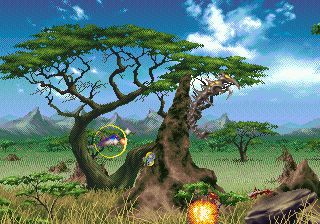 I’ve actually owned Kolibri for several years, but was put off for a while when I tried playing co-op with my girlfriend. We found it to be a totally frustrating experience, like a three-legged race gone completely wrong. Once we got past the first few levels, the game’s scrolling kept forcing our poor hummingbirds into bizarre contortions, often trapping one of us at the edge or corner of a screen, only to get picked off by a frog or shot by an instantly-respawning enemy. It wasn’t much fun at all, and when we got stuck shortly thereafter, we felt no qualms about packing it in.
I’ve actually owned Kolibri for several years, but was put off for a while when I tried playing co-op with my girlfriend. We found it to be a totally frustrating experience, like a three-legged race gone completely wrong. Once we got past the first few levels, the game’s scrolling kept forcing our poor hummingbirds into bizarre contortions, often trapping one of us at the edge or corner of a screen, only to get picked off by a frog or shot by an instantly-respawning enemy. It wasn’t much fun at all, and when we got stuck shortly thereafter, we felt no qualms about packing it in.
I hoped the single-player mode might be an improvement, but the scrolling issues are only somewhat better. The biggest problem, though, is the game’s dreadful control. Among several issues, I’ll single this one out: every time your hummingbird moves, he drifts to the right (or left). This means that if you try to gently tap upwards, nudging your bird through a tricky area, you’ll actually end up moving much farther horizontally than vertically. It’s a total mess that destroys any attempt at precision flying, and makes it impossible to call this game a real shooter.
So if it’s not a shooter, hummingbird-based or otherwise, what is Kolibri? Well, it tries to be a action game with puzzle elements, but the puzzles are terribly shallow. A good deal of the challenge comes from the poor gameplay explanations in the manual — I’d beaten the game twice before I realized how to properly trigger a Wall Breaker pod, since the manual doesn’t actually tell you how (you need to double-tap the A button; I’d just been button-mashing until something worked). And that’s really all the puzzles amount to, in the end: find a wall, find a Wall Breaker, break the wall, keep going.
And I kept going, through easy, normal, and hard, hoping to find a reason to like Kolibri. At least the designers had the good sense to offer unlimited continues, a password system, and checkpoints. But despite their wise decision, and despite the game’s attractive aesthetics and unique concept, I found Kolibri to be an essentially joyless experience. Ultimately, it gave me more enjoyment as a punchline than it ever did as a game.
Dragon’s Fury By The Coop
There was a time when I lived in a place with little in the way of stores to go for new Genesis games. We had a Walmart and a K-Mart, neither of which carried much for the Genesis at that time. I can remember reading issues of EGM and Mega Play, looking at all the cool things coming out, and wondering why so few of them seemed to show up in the local stores. Hell, the pawn shops around there had more in the way of a selection… or rather, two of them did. The other two were usually pretty minimal, but still, a pawn shop beating out a major chain in terms of Genesis game selection was just sad.
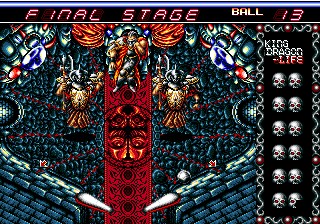 There was a game I eventually started seeing advertisements for, called Dragon’s Fury. It was a pinball game with a few twists, and I thought it looked cool. But of course, none of the stores where I lived carried it. However, I did see an ad later on that said games could be ordered straight from Tengen, the publisher of Dragon’s Fury, which was a port of the PC-Engine/TG-16 game Devil’s Crush. All I had to do was call, find out where to send a money order, and wait. Well it took a bit of convincing, but I got the money together, bought the money order, and sent it on its way. Still not being too familiar with how long things could take being mailed, I called Tengen a week later to find out if my order had been processed or not. Thankfully, they did have my order on record, and were able to tell me that it had been shipped… and that it would take upwards of two weeks to reach me. And so I waited, hoping that nothing would go wrong, and that my game would show up so I could enjoy it. And sure enough, near the end of the two week period, a package arrived for me in the mail from Tengen.
There was a game I eventually started seeing advertisements for, called Dragon’s Fury. It was a pinball game with a few twists, and I thought it looked cool. But of course, none of the stores where I lived carried it. However, I did see an ad later on that said games could be ordered straight from Tengen, the publisher of Dragon’s Fury, which was a port of the PC-Engine/TG-16 game Devil’s Crush. All I had to do was call, find out where to send a money order, and wait. Well it took a bit of convincing, but I got the money together, bought the money order, and sent it on its way. Still not being too familiar with how long things could take being mailed, I called Tengen a week later to find out if my order had been processed or not. Thankfully, they did have my order on record, and were able to tell me that it had been shipped… and that it would take upwards of two weeks to reach me. And so I waited, hoping that nothing would go wrong, and that my game would show up so I could enjoy it. And sure enough, near the end of the two week period, a package arrived for me in the mail from Tengen.
I tore open box it had been mailed in, smiled at my fresh and minty copy of Dragon’s Fury, and eagerly popped it into my Genesis. I got to hear the great TechnoSoft tunes, see the little demonic overtones and nice graphics, play through the multiple boards, and in time, watching the brief ending. I also came across a code to play with five remixed songs from other Tecno Soft games during the main board of Dragon’s Fury, four of which were from Thunder Force II (“Knights of Legend”), Thunder Force III (“Venus Fire”), Herzog Zwei (“A Breach of Contract”) and Elemental Master (“Blood-Stained Lake”). I loved every moment of it, and went back to it often for quick bouts of pinball action over the years. Sure, the game was edited a bit to get rid of the pentagrams and such, but it was still an enjoyable pinball game. It’s also the only time I ever ordered a title right from the publisher, back when such things were able to be done with some level of regularity. It was a unique way to get the game, but I’m glad I did it. And though Tengen often had a very up and down relationship with gamers, in this instance, they came through in a big way… for me at least.
Sadly, Tengen would go the other way and dash my hopes on the rocks by releasing an original follow-up called Dragon’s Revenge. The game looked nice, but the music and gameplay were busted. The physics were wonky, the boards were dull, the instruments were poor sounding, the music compositions were uninteresting with off-tempo issues, and the game just felt buggy. It was a bad sequel to say the least, and while it was only $10 new at Wal-Mart when I got it (yes, they skipped the good first game, and carried the piss-poor sequel… go figure), I still felt cheated. So I guess in a way, the Dragon did indeed get revenge on me for beating the first game; monetary revenge.
Jurassic Park by Frank Villone
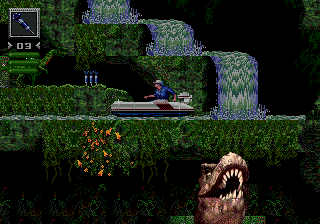 This past month did not offer the usual solid Genesis experience. Most months I can settle on one title to spend time with. That did not happen. Instead, I sifted through my library and revisited old games, none capturing my interest for an extended period. I even went to a previously-unvisited local retro store, and I cleaned them out! Still, nothing grabbed me.
This past month did not offer the usual solid Genesis experience. Most months I can settle on one title to spend time with. That did not happen. Instead, I sifted through my library and revisited old games, none capturing my interest for an extended period. I even went to a previously-unvisited local retro store, and I cleaned them out! Still, nothing grabbed me.
I ended up playing Jurassic Park, which I have had for ages. Specifically, I spent time in Grant’s third stage: The raft ride from hell! Dinosaur hell, that is. I remembered it from previous play-throughs, and strangely enough, it is one of my favorites. Of course, I would rather play as the raptor any day, but this stage is only for Grant.
If the aesthetics could be said to come together well at any point in Jurassic Park, this is it. The music is somewhat memorable: a light, fast rhythm, tapping over a deep bass line that sounds good humming through some bass-heavy stereo speakers. There is a frequent growl of synthesizer, plus the sound of a wave crashing. I enjoy it enough to put in the password for this stage, and then just leave Grant standing there, so that background music is provided for my bachelor pad. The jungle is dark but vibrant, as if sunlight is shining through the thick foliage in the distance, vague splotches of black and green.
The pulsing water rushes on, and with practice, it becomes a nice lazy river ride, while throwing grenades at all the dinosaurs along the way! Relaxation mixed with dinosaur violence – you can’t go wrong! Although I bet that the soothing qualities are not appreciated by most folks, who probably consider the stage to be little more than a cheap and frustrating experience.

@Sebastian Although my favorite level is the 2nd level with the mine cars, the levels following Black’s Dice Game are pretty fantastic: a space shooter followed by a level where you fight about eight bosses in a row. The only problem is that this time it’s a little more complex than simple pattern recognition like in level 2’s bosses.